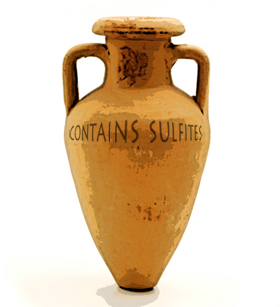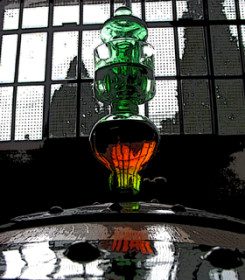Pain & Sulfuring.
Contrary to public opinion, wineries didn’t start adding sulfites to wine in 1987. That’s simply the year the US government dictated all wine containing more than 10 ppm, the smallest detectable amount at the time, be labeled with the warning “contains sulfites.”¹ If a winery can produce wine with less than 10 ppm of detectable sulfites they can forgo the warning label. I’ve sold organic wine for years and only once have I seen a label that read, “contains no detectable sulfites”. It may have been a misprint as the label should have read, “contains no detectable flavor”.
The warning label only applies to wines sold in America, leading many consumers to mistakenly believe that just those bottles destined for America are adulterated with sulfur while their European counterparts remain sulfite-free. The European Union has recently instituted a similar sulfur warning label so the idea that they are sulfite-free should soon be exposed as a myth – just like the idea that vampires can’t go out in daylight (like, have you even seen Twilight?).
Read MoreWild, Cultured or GM; Is Yeast a Fermenting Controversy?
Chapter Twelve. Part Five.
In an effort to tame the temperamental tribulations of fermentation, men have long tinkered with yeast, and as a result, winemakers now have many types of these little critters in their winemaking arsenal. Despite their differences, the one thing that all yeast organisms have figured out is how to convert sugar into alcohol, which is a far greater achievement than anything my college buddies have done with their lives.
Although wild yeast permeates the vineyards and wineries, many winemakers prefer to use cultured yeasts because they come from well-heeled families. Wild yeasts are uncultivated party animals and are therefore less predictable (of course unpredictable can also mean crazy-good). Think of it this way; uncultivated yeasts are like the wine bloggers of the fungi world but not quite as moldy.
Read MoreDon’t Be So Sensitive; Sensory Adaptation & Wine Tasting.
Chapter Two, Part Seven.
 As a regular reader of WineSnark, you’ve learned the various ways your body perceives flavor so now you can relax, have a bite to eat and enjoy a glass of wine. Once you do however, you might as well throw all you’ve learned into the recycle bin because when you introduce new chemical compounds to your body the equation changes. By the way, my wife just loves it when she cooks all day and I tell her she’s made a delicious “chemical compound”.
As a regular reader of WineSnark, you’ve learned the various ways your body perceives flavor so now you can relax, have a bite to eat and enjoy a glass of wine. Once you do however, you might as well throw all you’ve learned into the recycle bin because when you introduce new chemical compounds to your body the equation changes. By the way, my wife just loves it when she cooks all day and I tell her she’s made a delicious “chemical compound”.
Food is just one of the many things that can affect your sensory perceptions, most of which you can control about as well as a bad comb-over on a windy day.
Read More





















